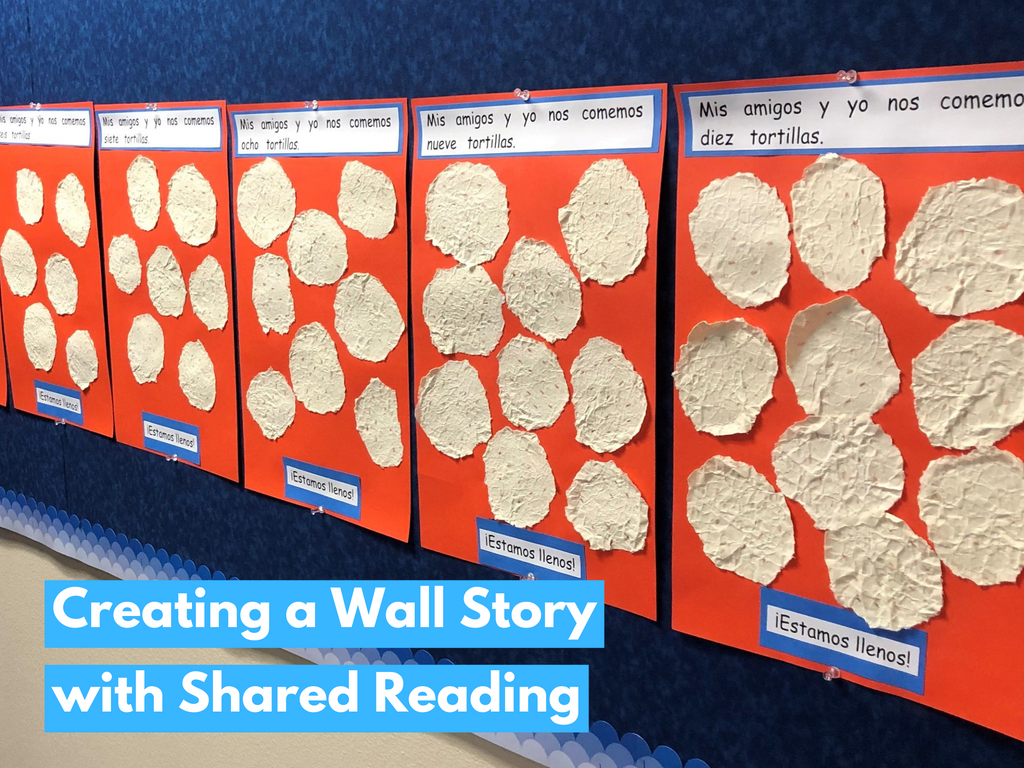By Marisa Morales
Students need to be immersed in a print-rich environment where they are given various opportunities to practice authentic reading and writing. Shared reading is one way that teachers can provide real-life literacy activities that engage all students at any language level. By mimicking lap stories read to children at home, shared reading instills a love of reading, creates community, and allows students to behave like readers with their teacher’s support. Shared reading teaches foundational literacy skills and early reading behaviors while simultaneously building students’ confidence as literacy learners.
In shared reading, an enlarged text is used so all students can see the print. There are a variety of options teachers can choose as the source of the text. A few examples include commercially published big books, texts enlarged using a document camera, teacher- or student-made books, poems and chants, or a wall story.
A wall story is a highly engaging resource that can be used for shared reading and is loved by students throughout the year during their independent reading time. Wall stories can be a retelling or innovation of a commercially published book and can also be related to a theme or concept currently being studied. The storyline can be created by the teacher or the students but is usually written by the teacher to ensure legibility. The students typically illustrate it. As indicated by its name, the wall story is posted on the wall for easy access by the children and can later be formatted into a book.
In this example, students read the big book Es un reptil, by Debbie Moeller, from Hameray’s Colección Caleidoscopio as a shared reading text.
The book has simple, repetitive text, with each page introducing a different reptile. As a follow-up to Es un reptil, the teacher creates a wall story about reptiles with a focus on punctuation. The teacher types the simple text in large, clear print, and the students use watercolors to paint the illustrations. The children feel ownership of the text because they participate in creating the illustrations.

Wall stories are a powerful resource in any primary classroom because they can be tailored to meet the needs of a teacher’s current group of students. The wall story based on Es un reptil could be made more complex by extending the second sentence on each page from one word to a more complex sentence:
Sí, un cocodrilo es un reptil. / Yes, a crocodile is a reptile.
or
Sí, un cocodrilo es un reptil porque tiene escamas. / Yes, a crocodile is a reptile because it has scales.
The concept could be made more complex by adding non-reptilian animals so that the answer varies between ‘sí / yes’ and ‘no.’
An additional feature of the wall story is the matching text. Each page of the wall story has a separate card that matches the text on that page. Students match the cards with the pages of the text, ensuring they attend to the print. Various text and print features can be emphasized when students match text, depending on the teacher’s focus and the level of the students.

Another example of a wall story is an innovation on the book Tortillas los domingos by Christine Jojola, another big book in Hameray’s Colección Caleidoscopio. Tortillas los domingos is a story about a group of siblings who make tortillas with their abuelita every Sunday.
A fun and easy wall story that kindergarten and first graders love to make and read after enjoying Tortillas los domingos has a simple text pattern: Mis amigos y yo nos comemos (insert #) tortillas. ¡Estamos llenos! / My friends and I ate (insert #) tortillas. We are full!
 Like before, the teacher has control over the level of text difficulty and can ensure that the complexity of the wall story matches the needs of her learners. In this example, students create the tortillas by tearing circles from construction paper, repeatedly crumpling the paper, and using crayons to color the tortillas.
Like before, the teacher has control over the level of text difficulty and can ensure that the complexity of the wall story matches the needs of her learners. In this example, students create the tortillas by tearing circles from construction paper, repeatedly crumpling the paper, and using crayons to color the tortillas.

Shared reading is an integral component of the primary classroom, and wall stories are a creative text resource that students of all literacy and language levels eagerly engage in. These stories often become class favorites and are revisited countless times throughout the year. Teachers can create wall stories that support and challenge their learners while simultaneously building a love of reading.
~~~
Colección Caleidoscopio comprises 180 wonderfully diverse Spanish leveled readers, both fiction and nonfiction, with 30 big books to choose from. Various authors and illustration styles keep the content fresh as your student moves to higher levels. Guided reading levels A–K. Also available in English.
~~~
Marisa Morales has been teaching for over 25 years. She has spent the last 14 years as a Reading Recovery/Descubriendo la Lectura Teacher Leader in Washington State. Marisa started her teaching career as a K-5 Special Education teacher and taught bilingual first grade for several years. She is passionate about teaching struggling readers, particularly students learning to read in Spanish.









